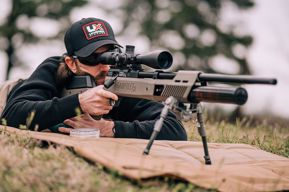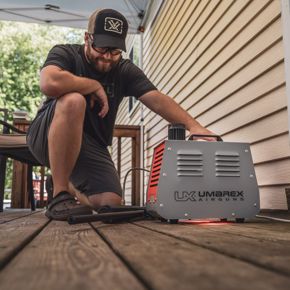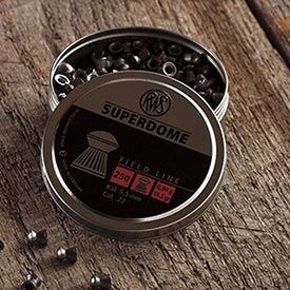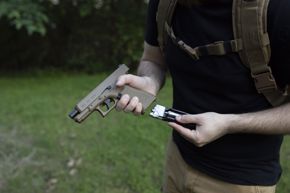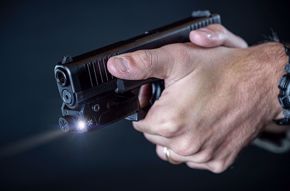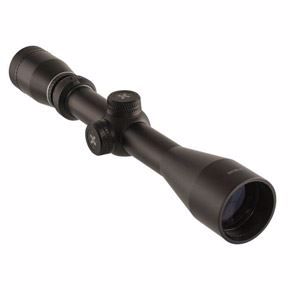The most modern of the Umarex 1911 air guns is this version of the Colt CQBP. Some Marines are fielding the .45 ACP version, and are most pleased with the modern take on the old John Moses Browning design. This one shoots BBs. It is a faithful reproduction of the .45’s aesthetics, with some notable differences in functionality.
Long after the Marines switched over to the Beretta 9mm, many were still longing for their old single-actions. Many more wanted more firepower. They asked for an updated 1911, and they got it. CQBP stands for Close Quarters Battle Pistol. The never-ending M9 vs. 1911 debate may be partially resolved, now that the Army is adopting a SIG, but fans of the 1911 still want a 1911.
The Colt beat out two other contenders in 2012. The new M45A1 CQBPs are used by the Marine Corps Special Operations Command (MARSOC), Marine Expeditionary Unit Special Operation Command, Force Recon, Special Reaction Teams (SRT) and even the Marine Corps pistol team.
The Umarex/Colt collaboration sports a two-tone frame. The look is spot on for the CQBP. Under the hood, of course, this is a BB gun. But while some of the Umarex 1911s are detailed clones of 1911 functionality, this one has some modifications.
Let’s start with the obvious similarities. This Colt has some aggressive grips. While they’re not G10, they are stylish and functional. This one has fast 3-dot sights. The serrations at the front and rear of the slide match those on the original. This one even has a functional, ambidextrous thumb safety.
If you saw the two side by side, it would be hard to tell them apart. The BB gun version of the CQBP will even fit in duty holsters meant for the .45 ACP.
The frame on this one has a smooth front strap. The mainspring housing is flat instead of arched, like the more antiquated 1911 A1s. It is equipped with a lanyard loop. The frame even has the feel of a ceramic coating.
Now let’s go through what is decidedly un-1911 about this one. For starters, the grip safety isn’t functional. While it has the feel of a large beavertail grip, it isn’t a moving part. It will not engage or disengage any safety. The hammer is skeletonized, though, and sinks nicely into the beavertail.
While we’re on the safety issue, I’ll point out that this gun’s thumb safety will engage with the hammer cocked (as it should) and with the hammer dropped (which isn’t supposed to happen on a 1911). This isn’t a show-stopper on this gun, though, and is a product of its unique trigger design.
The other aspect that is noticeable is the way the trigger moves. This trigger pull is long, and it arcs more like a rifle’s trigger. 1911 triggers push straight back into their frames. There is no arc in their travel. For the true devotee, this is going to be problematic. For those who don’t much care about the path of a 1911 trigger (and for those who don’t know), it won’t be a problem. But squeeze it all the way down.
The magazine on this gun is also different from some of those in the Umarex line. The CO2 is housed in the grip, and not in the magazine. That means there’s not room for a full-sized magazine to drop free. So the mags have a floorplate attached to a thin post that holds the BBs.
To access the CO2, you pull off a grip panel. The wrench to tighten it down is actually disguised as the back strap and slides right out. The design of the grip works well, but dropping magazines and reinserting them doesn’t replicate the feel of a 1911.
If you’re hoping to practice magazine change skills with this, though, I think there is an advantage to the thin design. It forces you to be more accurate. It isn’t exactly threading a needle, but it does require precision.
All told, I think this is a gun that is going to appeal to a younger shooter. We all know that teenager who is obsessed with the military. Many of us actually were that teenager many years ago. Who wouldn’t want a working homage to the CQBP?
If you are a 1911 purist at heart, the trigger may stick in your craw. But this is a BB gun. Once you master its unique manual of arms, the CQBP zips BBs down range.
David Higginbotham is a writer and educator who lives in Arkansas. After years of writing and consulting in the firearms industry, he's coming back to his roots with air guns.


